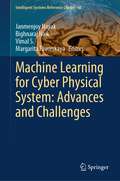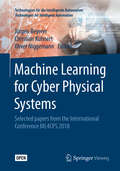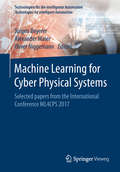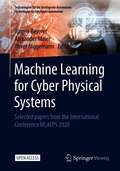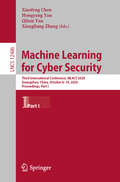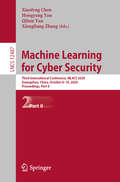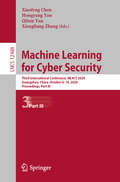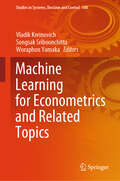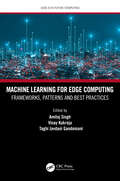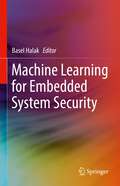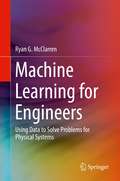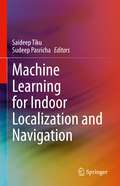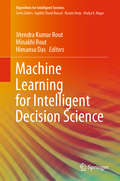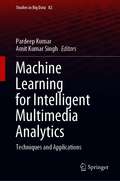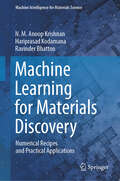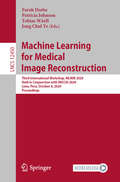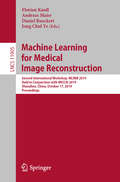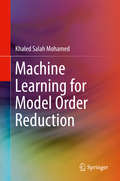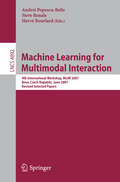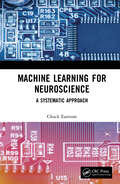- Table View
- List View
Machine Learning for Cyber Physical System: Advances and Challenges (Intelligent Systems Reference Library #60)
by Janmenjoy Nayak Bighnaraj Naik Vimal S. Margarita FavorskayaThis book provides a comprehensive platform for learning the state-of-the-art machine learning algorithms for solving several cybersecurity issues. It is helpful in guiding for the implementation of smart machine learning solutions to detect various cybersecurity problems and make the users to understand in combating malware, detect spam, and fight financial fraud to mitigate cybercrimes. With an effective analysis of cyber-physical data, it consists of the solution for many real-life problems such as anomaly detection, IoT-based framework for security and control, manufacturing control system, fault detection, smart cities, risk assessment of cyber-physical systems, medical diagnosis, smart grid systems, biometric-based physical and cybersecurity systems using advance machine learning approach. Filling an important gap between machine learning and cybersecurity communities, it discusses topics covering a wide range of modern and practical advance machine learning techniques, frameworks, and development tools to enable readers to engage with the cutting-edge research across various aspects of cybersecurity.
Machine Learning for Cyber Physical Systems
by Jürgen Beyerer Christian Kühnert Oliver NiggemannThis Open Access proceedings presents new approaches to Machine Learning for Cyber Physical Systems, experiences and visions. It contains some selected papers from the international Conference ML4CPS – Machine Learning for Cyber Physical Systems, which was held in Karlsruhe, October 23-24, 2018. Cyber Physical Systems are characterized by their ability to adapt and to learn: They analyze their environment and, based on observations, they learn patterns, correlations and predictive models. Typical applications are condition monitoring, predictive maintenance, image processing and diagnosis. Machine Learning is the key technology for these developments.
Machine Learning for Cyber Physical Systems: Selected papers from the International Conference ML4CPS 2017 (Technologien für die intelligente Automation #11)
by Jürgen Beyerer Alexander Maier Oliver NiggemannThe work presents new approaches to Machine Learning for Cyber Physical Systems, experiences and visions. It contains some selected papers from the international Conference ML4CPS – Machine Learning for Cyber Physical Systems, which was held in Lemgo, October 25th-26th, 2017. Cyber Physical Systems are characterized by their ability to adapt and to learn: They analyze their environment and, based on observations, they learn patterns, correlations and predictive models. Typical applications are condition monitoring, predictive maintenance, image processing and diagnosis. Machine Learning is the key technology for these developments.
Machine Learning for Cyber Physical Systems: Selected papers from the International Conference ML4CPS 2020 (Technologien für die intelligente Automation #13)
This open access proceedings presents new approaches to Machine Learning for Cyber Physical Systems, experiences and visions. It contains selected papers from the fifth international Conference ML4CPS – Machine Learning for Cyber Physical Systems, which was held in Berlin, March 12-13, 2020. Cyber Physical Systems are characterized by their ability to adapt and to learn: They analyze their environment and, based on observations, they learn patterns, correlations and predictive models. Typical applications are condition monitoring, predictive maintenance, image processing and diagnosis. Machine Learning is the key technology for these developments.
Machine Learning for Cyber Security: Third International Conference, ML4CS 2020, Guangzhou, China, October 8–10, 2020, Proceedings, Part I (Lecture Notes in Computer Science #12486)
by Xiaofeng Chen Hongyang Yan Qiben Yan Xiangliang ZhangThis three volume book set constitutes the proceedings of the Third International Conference on Machine Learning for Cyber Security, ML4CS 2020, held in Xi’an, China in October 2020.The 118 full papers and 40 short papers presented were carefully reviewed and selected from 360 submissions. The papers offer a wide range of the following subjects: Machine learning, security, privacy-preserving, cyber security, Adversarial machine Learning, Malware detection and analysis, Data mining, and Artificial Intelligence.
Machine Learning for Cyber Security: Third International Conference, ML4CS 2020, Guangzhou, China, October 8–10, 2020, Proceedings, Part II (Lecture Notes in Computer Science #12487)
by Xiaofeng Chen Hongyang Yan Qiben Yan Xiangliang ZhangThis three volume book set constitutes the proceedings of the Third International Conference on Machine Learning for Cyber Security, ML4CS 2020, held in Xi’an, China in October 2020.The 118 full papers and 40 short papers presented were carefully reviewed and selected from 360 submissions. The papers offer a wide range of the following subjects: Machine learning, security, privacy-preserving, cyber security, Adversarial machine Learning, Malware detection and analysis, Data mining, and Artificial Intelligence.
Machine Learning for Cyber Security: Third International Conference, ML4CS 2020, Guangzhou, China, October 8–10, 2020, Proceedings, Part III (Lecture Notes in Computer Science #12488)
by Xiaofeng Chen Hongyang Yan Qiben Yan Xiangliang ZhangThis three volume book set constitutes the proceedings of the Third International Conference on Machine Learning for Cyber Security, ML4CS 2020, held in Xi’an, China in October 2020.The 118 full papers and 40 short papers presented were carefully reviewed and selected from 360 submissions. The papers offer a wide range of the following subjects: Machine learning, security, privacy-preserving, cyber security, Adversarial machine Learning, Malware detection and analysis, Data mining, and Artificial Intelligence.
Machine Learning for Econometrics and Related Topics (Studies in Systems, Decision and Control #508)
by Vladik Kreinovich Songsak Sriboonchitta Woraphon YamakaIn the last decades, machine learning techniques – especially techniques of deep learning – led to numerous successes in many application areas, including economics. The use of machine learning in economics is the main focus of this book; however, the book also describes the use of more traditional econometric techniques. Applications include practically all major sectors of economics: agriculture, health (including the impact of Covid-19), manufacturing, trade, transportation, etc. Several papers analyze the effect of age, education, and gender on economy – and, more generally, issues of fairness and discrimination.We hope that this volume will:help practitioners to become better knowledgeable of the state-of-the-art econometric techniques, especially techniques of machine learning,and help researchers to further develop these important research directions. We want to thank all the authors for their contributions and all anonymous referees for their thorough analysis and helpful comments.
Machine Learning for Edge Computing: Frameworks, Patterns and Best Practices (ISSN)
by Amitoj SinghThis book divides edge intelligence into AI for edge (intelligence-enabled edge computing) and AI on edge (artificial intelligence on edge). It focuses on providing optimal solutions to the key concerns in edge computing through effective AI technologies, and it discusses how to build AI models, i.e., model training and inference, on edge. This book provides insights into this new inter-disciplinary field of edge computing from a broader vision and perspective. The authors discuss machine learning algorithms for edge computing as well as the future needs and potential of the technology. The authors also explain the core concepts, frameworks, patterns, and research roadmap, which offer the necessary background for potential future research programs in edge intelligence.The target audience of this book includes academics, research scholars, industrial experts, scientists, and postgraduate students who are working in the field of Internet of Things (IoT) or edge computing and would like to add machine learning to enhance the capabilities of their work. This book explores the following topics: Edge computing, hardware for edge computing AI, and edge virtualization techniques Edge intelligence and deep learning applications, training, and optimization Machine learning algorithms used for edge computing Reviews AI on IoT Discusses future edge computing needs Amitoj Singh is an Associate Professor at the School of Sciences of Emerging Technologies, Jagat Guru Nanak Dev Punjab State Open University, Punjab, India.Vinay Kukreja is a Professor at the Chitkara Institute of Engineering and Technology, Chitkara University, Punjab, India.Taghi Javdani Gandomani is an Assistant Professor at Shahrekord University, Shahrekord, Iran.
Machine Learning for Edge Computing: Frameworks, Patterns and Best Practices (ISSN)
by Amitoj Singh Vinay Kukreja Taghi Javdani GandomaniThis book divides edge intelligence into AI for edge (intelligence-enabled edge computing) and AI on edge (artificial intelligence on edge). It focuses on providing optimal solutions to the key concerns in edge computing through effective AI technologies, and it discusses how to build AI models, i.e., model training and inference, on edge. This book provides insights into this new inter-disciplinary field of edge computing from a broader vision and perspective. The authors discuss machine learning algorithms for edge computing as well as the future needs and potential of the technology. The authors also explain the core concepts, frameworks, patterns, and research roadmap, which offer the necessary background for potential future research programs in edge intelligence.The target audience of this book includes academics, research scholars, industrial experts, scientists, and postgraduate students who are working in the field of Internet of Things (IoT) or edge computing and would like to add machine learning to enhance the capabilities of their work. This book explores the following topics: Edge computing, hardware for edge computing AI, and edge virtualization techniques Edge intelligence and deep learning applications, training, and optimization Machine learning algorithms used for edge computing Reviews AI on IoT Discusses future edge computing needs Amitoj Singh is an Associate Professor at the School of Sciences of Emerging Technologies, Jagat Guru Nanak Dev Punjab State Open University, Punjab, India.Vinay Kukreja is a Professor at the Chitkara Institute of Engineering and Technology, Chitkara University, Punjab, India.Taghi Javdani Gandomani is an Assistant Professor at Shahrekord University, Shahrekord, Iran.
Machine Learning for Embedded System Security
by Basel HalakThis book comprehensively covers the state-of-the-art security applications of machine learning techniques. The first part explains the emerging solutions for anti-tamper design, IC Counterfeits detection and hardware Trojan identification. It also explains the latest development of deep-learning-based modeling attacks on physically unclonable functions and outlines the design principles of more resilient PUF architectures. The second discusses the use of machine learning to mitigate the risks of security attacks on cyber-physical systems, with a particular focus on power plants. The third part provides an in-depth insight into the principles of malware analysis in embedded systems and describes how the usage of supervised learning techniques provides an effective approach to tackle software vulnerabilities.
Machine Learning for Engineers: Using data to solve problems for physical systems
by Ryan G. McClarrenAll engineers and applied scientists will need to harness the power of machine learning to solve the highly complex and data intensive problems now emerging. This text teaches state-of-the-art machine learning technologies to students and practicing engineers from the traditionally “analog” disciplines—mechanical, aerospace, chemical, nuclear, and civil. Dr. McClarren examines these technologies from an engineering perspective and illustrates their specific value to engineers by presenting concrete examples based on physical systems. The book proceeds from basic learning models to deep neural networks, gradually increasing readers’ ability to apply modern machine learning techniques to their current work and to prepare them for future, as yet unknown, problems. Rather than taking a black box approach, the author teaches a broad range of techniques while conveying the kinds of problems best addressed by each. Examples and case studies in controls, dynamics, heat transfer, and other engineering applications are implemented in Python and the libraries scikit-learn and tensorflow, demonstrating how readers can apply the most up-to-date methods to their own problems. The book equally benefits undergraduate engineering students who wish to acquire the skills required by future employers, and practicing engineers who wish to expand and update their problem-solving toolkit.
Machine Learning for Future Wireless Communications (Wiley - IEEE)
by Fa-Long LuoA comprehensive review to the theory, application and research of machine learning for future wireless communications In one single volume, Machine Learning for Future Wireless Communications provides a comprehensive and highly accessible treatment to the theory, applications and current research developments to the technology aspects related to machine learning for wireless communications and networks. The technology development of machine learning for wireless communications has grown explosively and is one of the biggest trends in related academic, research and industry communities. Deep neural networks-based machine learning technology is a promising tool to attack the big challenge in wireless communications and networks imposed by the increasing demands in terms of capacity, coverage, latency, efficiency flexibility, compatibility, quality of experience and silicon convergence. The author – a noted expert on the topic – covers a wide range of topics including system architecture and optimization, physical-layer and cross-layer processing, air interface and protocol design, beamforming and antenna configuration, network coding and slicing, cell acquisition and handover, scheduling and rate adaption, radio access control, smart proactive caching and adaptive resource allocations. Uniquely organized into three categories: Spectrum Intelligence, Transmission Intelligence and Network Intelligence, this important resource: Offers a comprehensive review of the theory, applications and current developments of machine learning for wireless communications and networks Covers a range of topics from architecture and optimization to adaptive resource allocations Reviews state-of-the-art machine learning based solutions for network coverage Includes an overview of the applications of machine learning algorithms in future wireless networks Explores flexible backhaul and front-haul, cross-layer optimization and coding, full-duplex radio, digital front-end (DFE) and radio-frequency (RF) processing Written for professional engineers, researchers, scientists, manufacturers, network operators, software developers and graduate students, Machine Learning for Future Wireless Communications presents in 21 chapters a comprehensive review of the topic authored by an expert in the field.
Machine Learning for Future Wireless Communications (Wiley - IEEE)
A comprehensive review to the theory, application and research of machine learning for future wireless communications In one single volume, Machine Learning for Future Wireless Communications provides a comprehensive and highly accessible treatment to the theory, applications and current research developments to the technology aspects related to machine learning for wireless communications and networks. The technology development of machine learning for wireless communications has grown explosively and is one of the biggest trends in related academic, research and industry communities. Deep neural networks-based machine learning technology is a promising tool to attack the big challenge in wireless communications and networks imposed by the increasing demands in terms of capacity, coverage, latency, efficiency flexibility, compatibility, quality of experience and silicon convergence. The author – a noted expert on the topic – covers a wide range of topics including system architecture and optimization, physical-layer and cross-layer processing, air interface and protocol design, beamforming and antenna configuration, network coding and slicing, cell acquisition and handover, scheduling and rate adaption, radio access control, smart proactive caching and adaptive resource allocations. Uniquely organized into three categories: Spectrum Intelligence, Transmission Intelligence and Network Intelligence, this important resource: Offers a comprehensive review of the theory, applications and current developments of machine learning for wireless communications and networks Covers a range of topics from architecture and optimization to adaptive resource allocations Reviews state-of-the-art machine learning based solutions for network coverage Includes an overview of the applications of machine learning algorithms in future wireless networks Explores flexible backhaul and front-haul, cross-layer optimization and coding, full-duplex radio, digital front-end (DFE) and radio-frequency (RF) processing Written for professional engineers, researchers, scientists, manufacturers, network operators, software developers and graduate students, Machine Learning for Future Wireless Communications presents in 21 chapters a comprehensive review of the topic authored by an expert in the field.
Machine Learning for Indoor Localization and Navigation
by Saideep Tiku Sudeep PasrichaWhile GPS is the de-facto solution for outdoor positioning with a clear sky view, there is no prevailing technology for GPS-deprived areas, including dense city centers, urban canyons, buildings and other covered structures, and subterranean facilities such as underground mines, where GPS signals are severely attenuated or totally blocked. As an alternative to GPS for the outdoors, indoor localization using machine learning is an emerging embedded and Internet of Things (IoT) application domain that is poised to reinvent the way we navigate in various indoor environments. This book discusses advances in the applications of machine learning that enable the localization and navigation of humans, robots, and vehicles in GPS-deficient environments. The book explores key challenges in the domain, such as mobile device resource limitations, device heterogeneity, environmental uncertainties, wireless signal variations, and security vulnerabilities. Countering these challenges can improve the accuracy, reliability, predictability, and energy-efficiency of indoor localization and navigation. The book identifies severalnovel energy-efficient, real-time, and robust indoor localization techniques that utilize emerging deep machine learning and statistical techniques to address the challenges for indoor localization and navigation. In particular, the book:Provides comprehensive coverage of the application of machine learning to the domain of indoor localization;Presents techniques to adapt and optimize machine learning models for fast, energy-efficient indoor localization;Covers design and deployment of indoor localization frameworks on mobile, IoT, and embedded devices in real conditions.
Machine Learning for Intelligent Decision Science (Algorithms for Intelligent Systems)
by Jitendra Kumar Rout Minakhi Rout Himansu DasThe book discusses machine learning-based decision-making models, and presents intelligent, hybrid and adaptive methods and tools for solving complex learning and decision-making problems under conditions of uncertainty. Featuring contributions from data scientists, practitioners and educators, the book covers a range of topics relating to intelligent systems for decision science, and examines recent innovations, trends, and practical challenges in the field. The book is a valuable resource for academics, students, researchers and professionals wanting to gain insights into decision-making.
Machine Learning for Intelligent Multimedia Analytics: Techniques and Applications (Studies in Big Data #82)
by Pardeep Kumar Amit Kumar SinghThis book presents applications of machine learning techniques in processing multimedia large-scale data. Multimedia such as text, image, audio, video, and graphics stands as one of the most demanding and exciting aspects of the information era. The book discusses new challenges faced by researchers in dealing with these large-scale data and also presents innovative solutions to address several potential research problems, e.g., enabling comprehensive visual classification to fill the semantic gap by exploring large-scale data, offering a promising frontier for detailed multimedia understanding, as well as extract patterns and making effective decisions by analyzing the large collection of data.
Machine Learning for Materials Discovery: Numerical Recipes And Practical Applications (Machine Intelligence For Materials Science Ser.)
by N. M. Anoop Krishnan Hariprasad Kodamana Ravinder BhattooMachine Learning for Medical Image Reconstruction: Third International Workshop, MLMIR 2020, Held in Conjunction with MICCAI 2020, Lima, Peru, October 8, 2020, Proceedings (Lecture Notes in Computer Science #12450)
by Farah Deeba Patricia Johnson Tobias Würfl Jong Chul YeThis book constitutes the refereed proceedings of the Third International Workshop on Machine Learning for Medical Reconstruction, MLMIR 2020, held in conjunction with MICCAI 2020, in Lima, Peru, in October 2020. The workshop was held virtually. The 15 papers presented were carefully reviewed and selected from 18 submissions. The papers are organized in the following topical sections: deep learning for magnetic resonance imaging and deep learning for general image reconstruction.
Machine Learning for Medical Image Reconstruction: Second International Workshop, MLMIR 2019, Held in Conjunction with MICCAI 2019, Shenzhen, China, October 17, 2019, Proceedings (Lecture Notes in Computer Science #11905)
by Florian Knoll Andreas Maier Daniel Rueckert Jong Chul YeThis book constitutes the refereed proceedings of the Second International Workshop on Machine Learning for Medical Reconstruction, MLMIR 2019, held in conjunction with MICCAI 2019, in Shenzhen, China, in October 2019. The 24 full papers presented were carefully reviewed and selected from 32 submissions. The papers are organized in the following topical sections: deep learning for magnetic resonance imaging; deep learning for computed tomography; and deep learning for general image reconstruction.
Machine Learning for Mobile Communications (Industry 5.0)
by Chiranji Lal Chowdhary Subrata Chowdhury Sinh Cong Lam Tushar Hrishikesh JawareMachine Learning for Mobile Communications will take readers on a journey from basic to advanced knowledge about mobile communications and machine learning. For learners at the basic level, this book volume discusses a wide range of mobile communications topics from the system level, such as system design and optimization, to the user level, such as power control and resource allocation. The authors also review state-of-the-art machine learning, one of the biggest emerging trends in both academia and industry. For learners at the advanced level, this book discusses solutions for long-term problems with future mobile communications such as resource allocation, security, power control, and spectral efficiency. The book brings together some of the top mobile communications and machine learning experts throughout the world, who contributed their knowledge and experience regarding system design and optimization.This book: Discusses the 5G new radio system design and architecture as specified in 3GPP documents. Highlights the challenges including security and privacy, energy, and spectrum efficiency from the perspective of 5G new radio systems. Identifies both theoretical and practical problems that can occur in mobile communication systems. Covers machine learning techniques such as autoencoder and Q-learning in a comprehensive manner. Explores how to apply machine learning techniques to mobile systems to solve modern problems. This book is for senior undergraduate and graduate students and academic researchers in the fields of electrical engineering, electronics and communication engineering, and computer engineering.
Machine Learning for Mobile Communications (Industry 5.0)
by Chiranji Lal Chowdhary Subrata Chowdhury Sinh Cong Lam Tushar Hrishikesh JawareMachine Learning for Mobile Communications will take readers on a journey from basic to advanced knowledge about mobile communications and machine learning. For learners at the basic level, this book volume discusses a wide range of mobile communications topics from the system level, such as system design and optimization, to the user level, such as power control and resource allocation. The authors also review state-of-the-art machine learning, one of the biggest emerging trends in both academia and industry. For learners at the advanced level, this book discusses solutions for long-term problems with future mobile communications such as resource allocation, security, power control, and spectral efficiency. The book brings together some of the top mobile communications and machine learning experts throughout the world, who contributed their knowledge and experience regarding system design and optimization.This book: Discusses the 5G new radio system design and architecture as specified in 3GPP documents. Highlights the challenges including security and privacy, energy, and spectrum efficiency from the perspective of 5G new radio systems. Identifies both theoretical and practical problems that can occur in mobile communication systems. Covers machine learning techniques such as autoencoder and Q-learning in a comprehensive manner. Explores how to apply machine learning techniques to mobile systems to solve modern problems. This book is for senior undergraduate and graduate students and academic researchers in the fields of electrical engineering, electronics and communication engineering, and computer engineering.
Machine Learning for Model Order Reduction
by Khaled Salah MohamedThis Book discusses machine learning for model order reduction, which can be used in modern VLSI design to predict the behavior of an electronic circuit, via mathematical models that predict behavior. The author describes techniques to reduce significantly the time required for simulations involving large-scale ordinary differential equations, which sometimes take several days or even weeks. This method is called model order reduction (MOR), which reduces the complexity of the original large system and generates a reduced-order model (ROM) to represent the original one. Readers will gain in-depth knowledge of machine learning and model order reduction concepts, the tradeoffs involved with using various algorithms, and how to apply the techniques presented to circuit simulations and numerical analysis.Introduces machine learning algorithms at the architecture level and the algorithm levels of abstraction;Describes new, hybrid solutions for model order reduction;Presents machine learning algorithms in depth, but simply;Uses real, industrial applications to verify algorithms.
Machine Learning for Multimodal Interaction: 4th International Workshop, MLMI 2007, Brno, Czech Republic, June 28-30, 2007, Revised Selected Papers (Lecture Notes in Computer Science #4892)
by Andrei Popescu-Belis Steve Renals Hervé BourlardMachine Learning for Neuroscience: A Systematic Approach
by Chuck EasttomThis book addresses the growing need for machine learning and data mining in neuroscience. The book offers a basic overview of the neuroscience, machine learning and the required math and programming necessary to develop reliable working models. The material is presented in a easy to follow user-friendly manner and is replete with fully working machine learning code. Machine Learning for Neuroscience: A Systematic Approach, tackles the needs of neuroscience researchers and practitioners that have very little training relevant to machine learning. The first section of the book provides an overview of necessary topics in order to delve into machine learning, including basic linear algebra and Python programming. The second section provides an overview of neuroscience and is directed to the computer science oriented readers. The section covers neuroanatomy and physiology, cellular neuroscience, neurological disorders and computational neuroscience. The third section of the book then delves into how to apply machine learning and data mining to neuroscience and provides coverage of artificial neural networks (ANN), clustering, and anomaly detection. The book contains fully working code examples with downloadable working code. It also contains lab assignments and quizzes, making it appropriate for use as a textbook. The primary audience is neuroscience researchers who need to delve into machine learning, programmers assigned neuroscience related machine learning projects and students studying methods in computational neuroscience.
